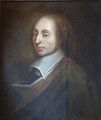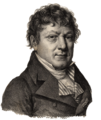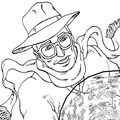Template:Selected anniversaries/August 19: Difference between revisions
No edit summary |
No edit summary |
||
| Line 19: | Line 19: | ||
||1765: Baron Axel Fredrik Cronstedt dies ... mineralogist and chemist who discovered nickel in 1751 as a mining expert with the Bureau of Mines. Cronstedt is one of the founders of modern mineralogy. Pic. | ||1765: Baron Axel Fredrik Cronstedt dies ... mineralogist and chemist who discovered nickel in 1751 as a mining expert with the Bureau of Mines. Cronstedt is one of the founders of modern mineralogy. Pic. | ||
||1785: Seth Thomas born ... clock manufacturer who was one of the pioneers in the mass production of clocks. After working with Eli Terry and Silas Hoadley in firm of Terry, Thomas & Hoadley, which manufactured clocks by mass production methods (1807), Thomas founded a clock factory of his own at Plymouth Hollow, Conn. (1812). He was not an inventive genius, but he was an excellent mechanic and a keen business man. Two years later he paid Terry for the rights to manufacture the latter's popular shelf clock. Shortly, he was selling as many clocks as Terry. As his business developed Thomas built a mill for rolling brass and making wire at Plymouth Hollow, and operated it in conjunction with the clock factory. Finally, he organized the Seth Thomas Clock Co. (1853). Pic. | |||
||1790: Edward John Dent born ... clockmaker and inventor whose chronometers were noted for high accuracy. His patents in this field included compasses for navigation and surveying. He experimented with springs made of steel, gold and glass, and devices for counteracting the effects of temperature change upon timepiece mechanisms. As clockmaker to Queen Victoria, he was commissioned to build the Great Clock for the clock tower of the Houses of Parliament (known as Big Ben, although that is actually the nickname of its hour bell) which he began in the year he died. His son, Frederick Dent, completed the work the following year and it was installed in the tower in 1859. It continues to be recognised for its great accuracy of 4 seconds in a year. Pic. | |||
||1808: James Nasmyth born ... engineer who invented the steam-hammer (24 Nov 1839) which was patented in Britain on 9 Jun 1842 (No. 9382). In his early career, Nasmyth improved the design of machine tools. Power hammers had previously been driven by steam, but Nasmyth designed his steam-hammer with more precision and control. The steam functioned to lift the hammer which then dropped by gravity, and repeated the cycle. Nasmyth adapted the idea to make a steam pile-driver. With later improvements, the steam-hammer enabled forging very large guns for the British navy. He became wealthy and in 1856 was able to retire at the age of 48. After retirement, Nasmyth pursued his hobby of astronomy, in which he published minor works. Pic. | |||
File:Jean Baptiste Joseph Delambre.png|link=Jean Baptiste Joseph Delambre (nonfiction)|1822: Mathematician and astronomer [[Jean Baptiste Joseph Delambre (nonfiction)|Jean Baptiste Joseph Delambre]] dies. He was one of the first astronomers to derive astronomical equations from analytical formulas. | File:Jean Baptiste Joseph Delambre.png|link=Jean Baptiste Joseph Delambre (nonfiction)|1822: Mathematician and astronomer [[Jean Baptiste Joseph Delambre (nonfiction)|Jean Baptiste Joseph Delambre]] dies. He was one of the first astronomers to derive astronomical equations from analytical formulas. | ||
File:Red Eyes Fighting.jpg|link=Red Eyes Fighting|1823: ''[[Red Eyes Fighting]]'' depicts martial artist and crime-fighter [[Red Eyes]] breaking up a [[math lab]]. | File:Red Eyes Fighting.jpg|link=Red Eyes Fighting|1823: ''[[Red Eyes Fighting]]'' depicts martial artist and crime-fighter [[Red Eyes]] breaking up a [[math lab]]. | ||
||1830: Julius Lothar Meyer born ... chemist who discovered the Periodic Law, independently of Dmitry Mendeleyev, at about the same time (1869). However, he did not develop the periodic classification of the chemical elements as thoroughly as Mendeleyev. Meyer trained originally in medicine and chemistry. He examined the effect of carbon monoxide on blood. In 1879, Meyer compared atomic volume to atomic weight. Plotted on a graph, the curve showed the periodicity of the elements. He also established the concept of valency by indicating that a given element combined with a characteristic number of hydrogen atoms, and coined the terms like univalent, bivalent, and trivalent, based on that number. Pic. | |||
||1854: The First Sioux War begins when United States Army soldiers kill Lakota chief Conquering Bear and in return are massacred. | ||1854: The First Sioux War begins when United States Army soldiers kill Lakota chief Conquering Bear and in return are massacred. | ||
| Line 29: | Line 37: | ||
||1871: Orville Wright, American engineer and pilot, co-founded the Wright Company. | ||1871: Orville Wright, American engineer and pilot, co-founded the Wright Company. | ||
||1883: Leonid Kulik born ... minerologist who conducted the first scientific expedition (for which records survive) to study the Tungusta meteor impact site. He began in 1927, and continued to work on the investigation until, while fighting for his country in WW II, he was captured and died of typhus in a Nazi prison camp. Pic. | |||
||1887: Alvan Clark dies ... astronomer whose family became the first significant manufacturers of astronomical instruments in the U.S. His company manufactured apparatus for most American observatories of the era, including Lick and Pulkovo, and others in Europe. In 1862, while testing a telescope, Clark discovered the companion star to Sirius, which had previously been predicted but until then never sighted. The 18½-in objective telescope he used was subsequently delivered to the Dearborn Observatory, Chicago. His sons, Alvan Graham Clark and George Bassett Clark, continued the business. The unexcelled 40-in refractor telescopes for the 40-in Yerkes observatory was made by Alvan Graham Clark. Pic. | |||
||1888: Erik Edlund dies ... physicist. His scientific research was confined chiefly to the theory of electricity. He helped secure the introduction of weather stations to Sweden. | ||1888: Erik Edlund dies ... physicist. His scientific research was confined chiefly to the theory of electricity. He helped secure the introduction of weather stations to Sweden. | ||
||1891: Milton La Salle Humason born ... astronomer. He became known as a meticulous observer, obtaining photographs and difficult spectrograms of faint galaxies. His observations played a major role in the development of physical cosmology. Pic: https://imagine.gsfc.nasa.gov/educators/programs/cosmictimes/downloads/newsletters/1929NL_LateEd.pdf | |||
||1897: Robert Brainard Corey born ... biochemist, mostly known for his role in discovery of the α-helix and the β-sheet with Linus Pauling. | ||1897: Robert Brainard Corey born ... biochemist, mostly known for his role in discovery of the α-helix and the β-sheet with Linus Pauling. | ||
File:Philo T Farnsworth.jpg|link=Philo Farnsworth (nonfiction)|1906: Inventor [[Philo Farnsworth (nonfiction)|Philo Farnsworth]] born. He will make many crucial contributions to the early development of all-electronic television. | File:Philo T Farnsworth.jpg|link=Philo Farnsworth (nonfiction)|1906: Inventor [[Philo Farnsworth (nonfiction)|Philo Farnsworth]] born. He will make many crucial contributions to the early development of all-electronic television. | ||
||Joseph Gilbert Hoffman born ... physicist and biophysicist who brought atomic isotopes into the battle against cancer. During WW II, he developed a radio proximity fuse and later was a health-physics scientist with "Manhattan Project." Hoffman studied nine accident victims of radiation disease at Los Alamos in Aug 1945 and May 1946. This research revealed for the first time that atoms of living human tissue could be transformed into radioactive atoms. He recognized "a completely new approach to studying the metabolism of atoms in living tissue and a new way of probing the complicated system of gene cells that determine heredity," and such knowledge was indispensable to understanding the mysteries of cancer research in which he engaged for the rest of his life. Pic: https://www.todayinsci.com/8/8_19.htm | |||
||1924: Willard Boyle born ... physicist and academic, Nobel Prize laureate. | ||1924: Willard Boyle born ... physicist and academic, Nobel Prize laureate. | ||
||1926: George Daniels born ... horologist who was considered to be the best in the world during his lifetime. He was one of the few modern watchmakers who built complete watches by hand (including the case and dial). But it was his creation of the coaxial escapement for which he is most remembered. The movement, which removed the need to add a lubricant, has been used by Omega in their highest-grade watches since 1999. Pic. https://en.wikipedia.org/wiki/George_Daniels_(watchmaker) | ||1926: George Daniels born ... horologist who was considered to be the best in the world during his lifetime. He was one of the few modern watchmakers who built complete watches by hand (including the case and dial). But it was his creation of the coaxial escapement for which he is most remembered. The movement, which removed the need to add a lubricant, has been used by Omega in their highest-grade watches since 1999. Pic. https://en.wikipedia.org/wiki/George_Daniels_(watchmaker) | ||
||1931: Aristides Agramonte y Simoni dies ... pathologist and bacteriologist who was a member of the Reed Yellow Fever Board of the U.S. Army that discovered (1901) the role of the mosquito in the transmission of yellow fever. In May 1898, he was appointed Acting Assistant Surgeon in the U.S. Army. Agramonte had acquired immunity to yellow fever from a mild childhood case in Cuba before emigrating to the U.S., which was an advantage when he was chosen by the Surgeon-General to study the yellow fever outbreak in General Shafter's army in Cuba. There Agramonte performed autopsies in order to determine the causative agent of the disease. After additional work in Cuba, in May 1900, Agramonte was appointmented to Walter Reed's Yellow Fever Commission. Pic. | |||
||1939: Alan Baker born ... mathematician, known for his work on effective methods in number theory, in particular those arising from transcendental number theory. Pic. | ||1939: Alan Baker born ... mathematician, known for his work on effective methods in number theory, in particular those arising from transcendental number theory. Pic. | ||
| Line 47: | Line 65: | ||
||1953: The CIA and MI6 help to overthrow the government of Mohammad Mosaddegh in Iran and reinstate the Shah Mohammad Reza Pahlavi. | ||1953: The CIA and MI6 help to overthrow the government of Mohammad Mosaddegh in Iran and reinstate the Shah Mohammad Reza Pahlavi. | ||
||Carl-Gustaf Rossby dies ... meteorologist who first explained the large-scale motions of the atmosphere in terms of fluid mechanics. His work contributed to developing meteorology as a science. Rossby first theorized about the existence of the jet stream in 1939, and that it governs the easterly movement of most weather. U.S. Army Air Corps pilots flying B-29 bombing missions across the Pacific Ocean during World War II proved the jet stream's existence. The pilots found that when they flew from east to west, they experienced slower arrival times and fuel shortage problems. When flying from west to east, however, they found the opposite to be true. Rossby created mathematical models (Rossby equations) for computerized weather prediction (1950). Pic. | |||
||1960: In Moscow, Russia, Soviet Union, downed American U-2 pilot Francis Gary Powers is sentenced to ten years imprisonment by the Soviet Union for espionage. | ||1960: In Moscow, Russia, Soviet Union, downed American U-2 pilot Francis Gary Powers is sentenced to ten years imprisonment by the Soviet Union for espionage. | ||
| Line 53: | Line 73: | ||
||1964: Syncom 3, the first geostationary communication satellite, was launched. | ||1964: Syncom 3, the first geostationary communication satellite, was launched. | ||
||1967: Hugo Gernsback dies ... inventor (80 patents) and publisher who was largely responsible for the establishment of science fiction as an independent literary form. Hugo founded radio station WRNY, was involved in the first television broadcasts and is considered a pioneer in amateur radio. In 1926, as owner of a magazine, Modern Electrics, he filled a blank spot in his publication by dashing off the first chapter of a series called "Ralph 124C 41+." "Ralph" was an amazing success. The 12-part story was filled with all kinds of wild inventions unheard of in 1926, including television (he is credited with introducing this word), fluorescent lighting, juke boxes, solar energy, television, microfilm, vending machines, and a device we now call radar. Pic. | |||
||1968: George Gamow dies ... nuclear physicist, cosmologist and writer who was one of the foremost advocates of the big-bang theory, which describes the origin of the universe as a colossal explosion that took place billions of years ago. In 1954, he expanded his interests into biochemistry and his work on deoxyribonucleic acid (DNA) made a basic contribution to modern genetic theory. Pic. | |||
||1982: Manali Kallat Vainu Bappu dies ... astronomer. In 1957, he discovered the Wilson-Bappu effect jointly with American astronomer Olin Chaddock Wilson. He is regarded as the father of modern Indian astronomy. Pic. | ||1982: Manali Kallat Vainu Bappu dies ... astronomer. In 1957, he discovered the Wilson-Bappu effect jointly with American astronomer Olin Chaddock Wilson. He is regarded as the father of modern Indian astronomy. Pic. | ||
Revision as of 17:20, 15 August 2018
1662: Mathematician, physicist, inventor, writer, and Christian philosopher Blaise Pascal dies. He did pioneering work on calculating machines.
1758: Jean-Étienne Montucla received the censor's approbation for his Histoire des mathematiques, which is justly famous as a history of the mathematical sciences.
1822: Mathematician and astronomer Jean Baptiste Joseph Delambre dies. He was one of the first astronomers to derive astronomical equations from analytical formulas.
1823: Red Eyes Fighting depicts martial artist and crime-fighter Red Eyes breaking up a math lab.
1906: Inventor Philo Farnsworth born. He will make many crucial contributions to the early development of all-electronic television.
1993: Actor-cryptographer Niles Cartouchian confirms that he personally designed the computational security protocols featured in the action-adventure film Dard Hunter, Glyph Warden.
1994: Chemist, biochemist, peace activist, author, and educator Linus Pauling dies.






